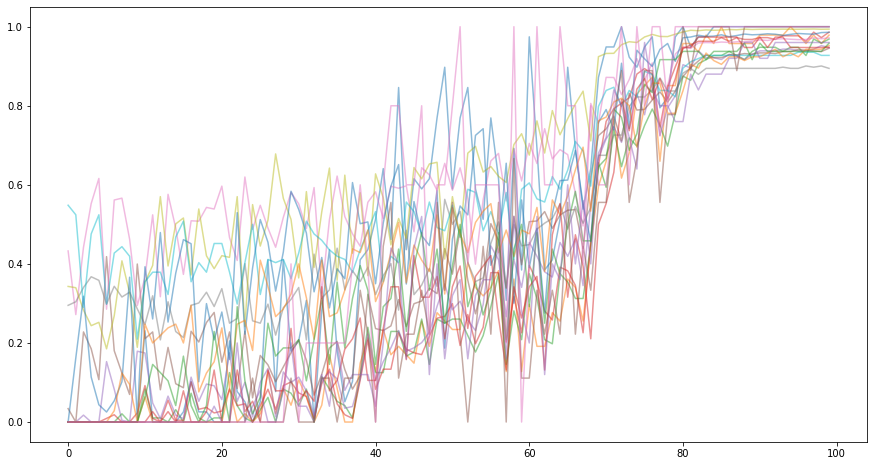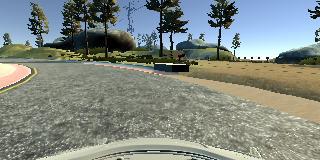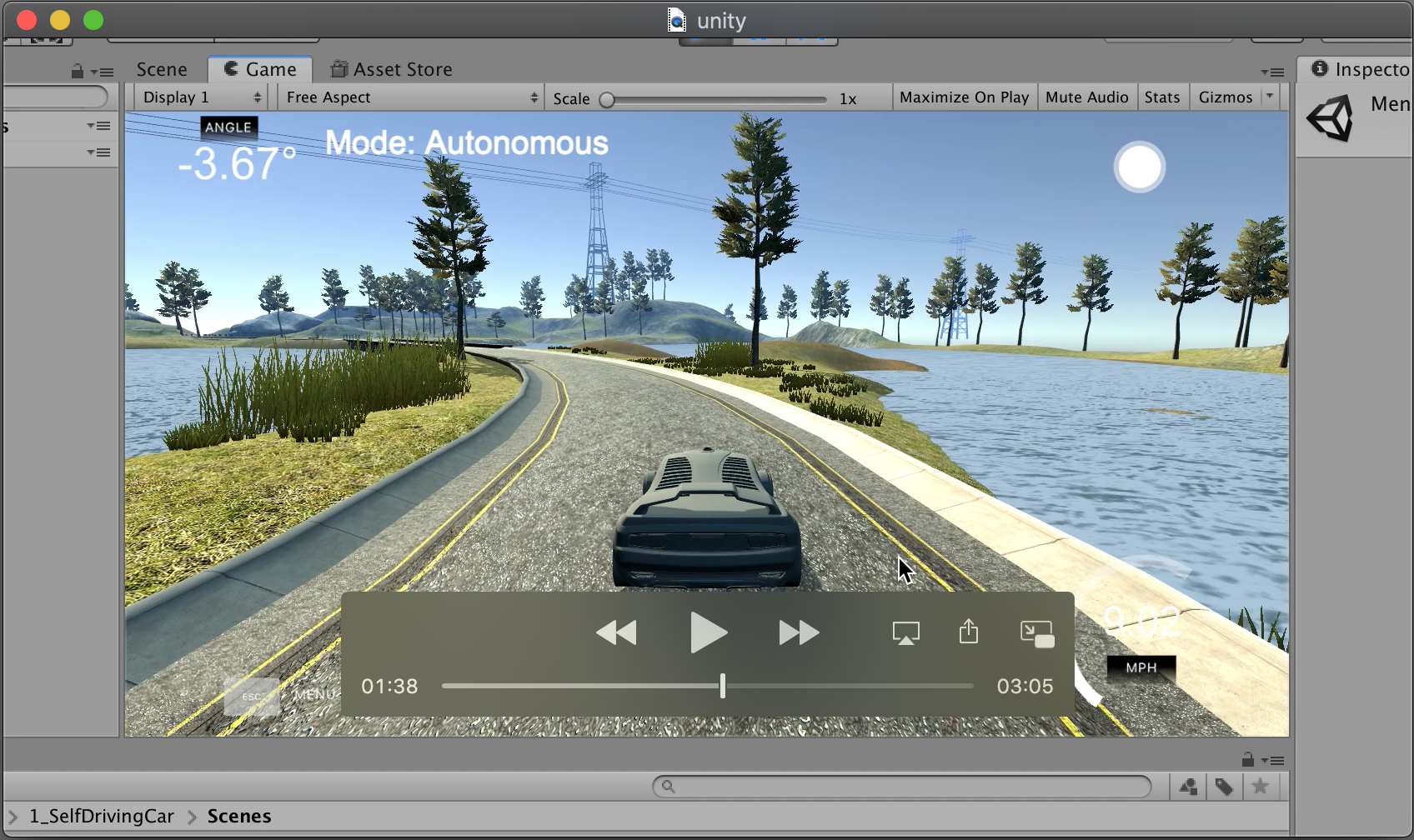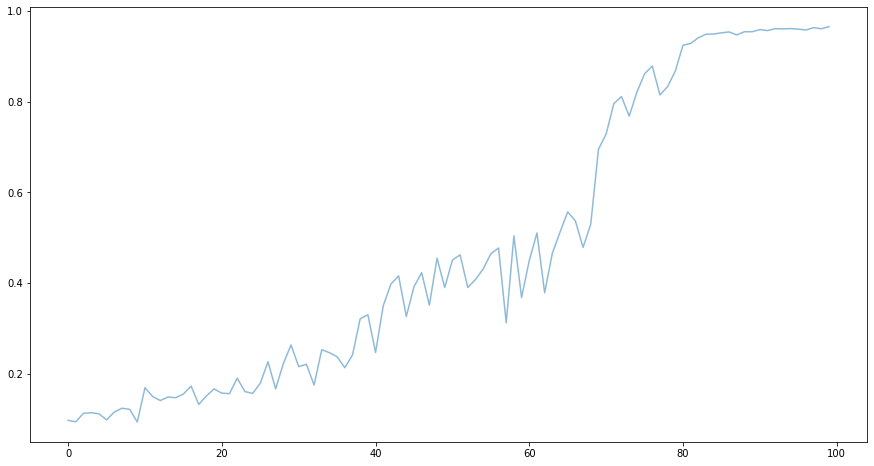Behavioral Cloning Project
Main task of the project is to prepare model in Keras framework to drive a car inside simulator made by Udacity available in this repo.
Simulator
The simulator is not an app as I expected from the start.
To run simulator it was needed to :
- Get Unity framework (Individual/Personal version was working fine)
- Use git-lfs to get repository
- Fix deprecated code inside simulator Assets/Standard Assets/Cameras/Scripts/TargetFieldOfView.cs -
if (!((r is TrailRenderer) || (r is ParticleRenderer) || (r is ParticleSystemRenderer)))the "(r is ParticleRenderer)" check was deleted and other stayed untouched so after change it stated:
if (!((r is TrailRenderer) || (r is ParticleSystemRenderer)))The simulator was ready to go:
Data Collection
I decided to collect drive data myself. It is qite challanging to drive car in the simulator - once you turn badly it gets even worse fast. After two learning circles I started recording.
One recordings clock-wise and two counter-clock-wise were recorder as the data for training.
Data Exploration
The data is very unbalanced. Most of the times car ges straight. Linear data histogram is:
To be able to tell more about the data log scale was applied to y-axis:
Since in training dataset there were mostly left-turns it is visible that negative values occur a bit more frequent.
Data Preprocessing
To cut off areas that should not affect the driving I calculated 'the mean frame' of all recordings. Then Region Of Interest was marked.
Data was normalized to range [-1;1]
Side images
The simulator generates images from three points:
- center of a car
- left side of a car
- right side of a car All camera look forward.
A trick was used to extend dataset. All side images look like they need turn in tenrms of 'cneter camera' so they were used as samples requiring turning. Used coefficient for those cameas was equal to 0.2.
Data split
Classic data split to train/val/test subset is questionable for gathered data. Even though it was considered I firstly tried without this split to check how model will behave.
Reason why the data split is questionable is that gathered data differ in each iteration. No driver can reproduce EXACT the same results each circle so no real GRAOUND TRUTH can be easily found.
That's why validation of model will be mane not in terms of validation metrics but in terms of visual result for this case.
Dropout layer has been introduced to keep model from overfitting.
Metrics
Main metric used in training was mean squared error (MSE). While having angle data collected from keyboard presses it has local peaks when driver decided to 'fix' the driving angle so exact match is also questionable. It also makes MSE metric hard to interpret.
The main question that readabe metric must answer is 'does the car fix the angle when it should'.
Also the 'accuracy' is the simplies metric to understand.
Theresore I created metric that will tell me how the model behaves.
All possible rangel of values (between 1 and -1) were split into bins. Odd number of bins makes "zero value"(go stright) always fall into same bin. Number 17 was chosen as the bin number. Therefore the bins are ranges:
[-1. , -0.88235294],
[-0.88235294, -0.76470588],
[-0.76470588, -0.64705882],
[-0.64705882, -0.52941176],
[-0.52941176, -0.41176471],
[-0.41176471, -0.29411765],
[-0.29411765, -0.17647059],
[-0.17647059, -0.05882353],
[-0.05882353, 0.05882353],
[ 0.05882353, 0.17647059],
[ 0.17647059, 0.29411765],
[ 0.29411765, 0.41176471],
[ 0.41176471, 0.52941176],
[ 0.52941176, 0.64705882],
[ 0.64705882, 0.76470588],
[ 0.76470588, 0.88235294],
[ 0.88235294, 1. ]The accuracy is considered as how many turning angles fall into the right bin. That makes accuracy with value freedom of +/-0.059 . So about +/- 3% (6% right and 6% left) of range error is tolerable.
Model
The size of processed image (after cropping) is 320x70 pixels in 3 channels. Classig models with convolution and pooling blocks could easily shring this height of 70 to very small number. Therefore model with no max-pooling layers was created.
The model contains:
- 3 convolution layers to extract low and high level features
- global pooling layer to average existance of features on image
- 2 dense layers to regress angle value
Details:
List of layers:
- Normalize
- Crop2D
- Conv2d with 5x5 kernel, padding valid, ReLU activation
- Conv2d with 3x3 kernel, padding valid, ReLU activation
- Conv2d with 3x3 kernel, padding valid, ReLU activation
- Conv2d with 3x3 kernel, padding valid, ReLU activation
- Global Average Pooling
- Dense with ReLU activation
- (Dropout) with rate 0.5 used during training
- Dense without activation
_________________________________________________________________
Layer (type) Output Shape Param #
=================================================================
lambda_15 (Lambda) (None, 160, 320, 3) 0
_________________________________________________________________
cropping2d_15 (Cropping2D) (None, 70, 320, 3) 0
_________________________________________________________________
conv2d_36 (Conv2D) (None, 66, 316, 16) 1216
_________________________________________________________________
conv2d_37 (Conv2D) (None, 64, 314, 32) 4640
_________________________________________________________________
conv2d_38 (Conv2D) (None, 62, 312, 64) 18496
_________________________________________________________________
conv2d_39 (Conv2D) (None, 60, 310, 128) 73856
_________________________________________________________________
global_average_pooling2d_14 (None, 128) 0
_________________________________________________________________
dense_23 (Dense) (None, 32) 4128
_________________________________________________________________
dropout_22 (Dropout) (None, 32) 0
_________________________________________________________________
dense_24 (Dense) (None, 1) 33
=================================================================
Total params: 102,369
Trainable params: 102,369
Non-trainable params: 0Number of parameters is still low so the model is able to work on CPU with reasonable speed after training. Model size saved on disk is 436 KB
Training
Training was peformed using:
- 100 epochs
- Adam Optimizer with starting learning rate equal to 0.001
- Mean Squared Error Loss
- ReduceOnPlateau learning rate scheduler with factor of 0.2 and patience of 2 epochs (considering loss value)
Big number of epochs and reduce on plateau strategy were used to check if model is able to learn interepret features and how many epochs it will take to train model for 95%+ accuracy.
There were 3 reduces of learning rates:
Epoch 00069: ReduceLROnPlateau reducing learning rate to 0.00020000000949949026.
Epoch 00080: ReduceLROnPlateau reducing learning rate to 4.0000001899898055e-05.
Epoch 00083: ReduceLROnPlateau reducing learning rate to 1e-05.
It's visible that loss curve converges after 80 epoch.
Accuracy:
Plot for bins accuracy (mentioned above) was also done:

Since the plot is hadr to interpret because of number of bins averagle plot was done:
The accuracy also seem to converge after epoch 80.
Validation Results - Autonomous drive
Having overfitted model might end badly on data from outsithe the dataset. That's why the simulator was used in autonomus drive mode with usage of trained model.
Modified code from Udacity Project's repository was used:
Result frames generated automatically merged into video:

Similar recording of autonomus drive taken from screen capture can be seen below. It can be said it works in realtime. (this is h265 encoded video to keep it reasonably small):

Discussion
Data augmentation
To lower overfitting some data augmentation could be introduced. For example brightness, contrast, blur, gaussian noise, monior shift, and minor rotate.
Cross-entropy training
Fitting to Mean Square Loss is a bit too much considering uncertainity of gathered data. Intoducing cross-entropy loss for fitting the right bin could lowe overfitting and focus more on "it should be slight left: instead of matching the value.
Regularization
Batch Norm layers could also prevent overfitting - if there were any outlying frames it could properly address thise issues.
Data collection
Data collected from 3 laps seems to be very little data. For the real life scenario even for track like this the dataset shuld contain data from many times in the day, many weather conditions, many drivers to start taking about trusting it the model.
Constant fixing issue
Autonomous drive at the momen is fixing the angle every frame. A mechanism of averaging should be considered t make position of the car more stable.







